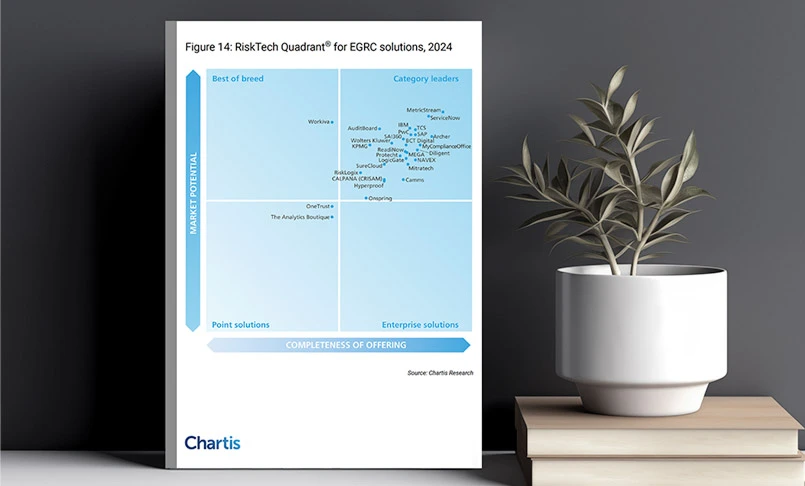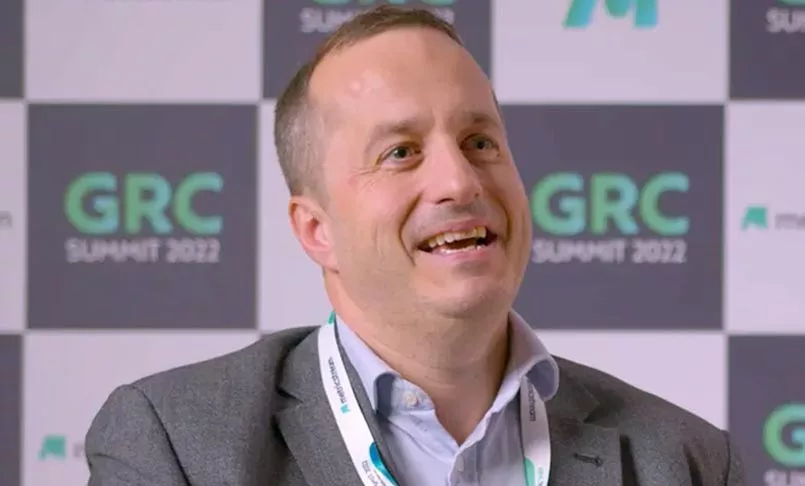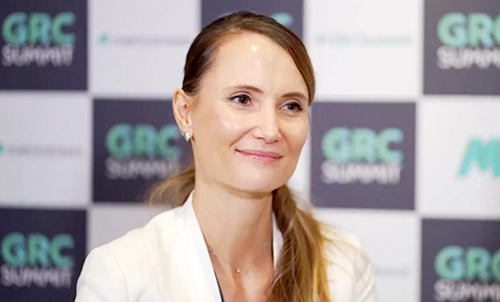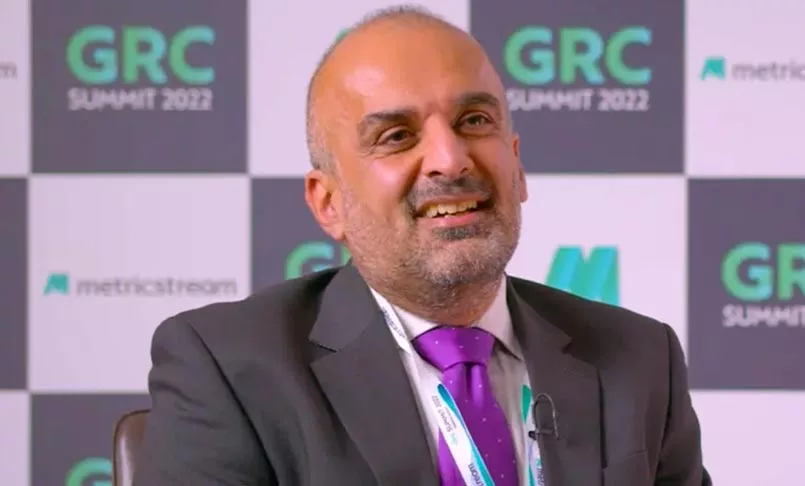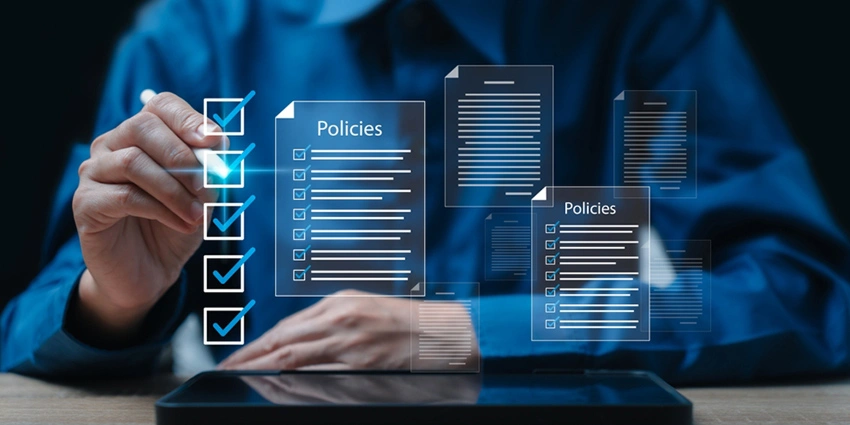A Look Back at the GRC Summit 2019
- Audit Management
- 30 July 19

Introduction
Now in its seventh year, the GRC Summit hosted by MetricStream is one of the biggest and most anticipated events for GRC practitioners around the world. This year, the summit was held on June 2-5 in Baltimore, Maryland, bringing together over 450 GRC and business leaders to talk about the latest trends and opportunities in GRC. It was an incredible four days of learning, discovery, and collaboration—topped off by an exclusive cruise, as well as a glittering awards ceremony.
Here are some of the top highlights from the summit:
- Integrity Front and Center
In keeping with the theme of the summit—”Perform with Integrity™”—many of the speakers pointed out that financial performance is no longer the sole indicator of success. Trust is what really drives business today, and integrity is what drives trust.
MetricStream CEO, Mikael Hagstroem talked about building integrity by fostering a sense of compassion in the way we approach customers, the way we treat employees, and the way we shape the future of technology. “Successful performance—be it an individual level, an organizational level, or a global level—begins with a spark of passion that, when guided by integrity and compassion, helps us improve the human condition, and enable a higher quality of life,” he said.
MetricStream Chairman, Gunjan Sinha, emphasized the need to build purpose-driven organizations where doing good is as much of a priority as doing well. A strong sense of purpose, he predicted, is what will define the successful organizations of the future, along with a commitment to diversity, inclusion, empowerment of the front line, ethical data, and social conscious AI.

- Tony Scott on the Key Transformation Drivers of the Next Five Years
The former Chief Information Officer of the United States government (2015-17) described how “relentless digitization” is rapidly upending traditional analog business models. And with it, the notion of security and privacy by design is becoming more important than ever. Technology is moving faster than we’re prepared for, he cautioned. Do we understand the risks of new tools like AI and machine learning? How do we build good governance, accountability, and transparency around these new technologies? How do we keep humanity at the center of innovation? All key questions to consider.

- Jim Quigley: Coping with the “Knowns” and “Unknowns” of Business
Drawing on his experience as a member of the board and risk committee at Wells Fargo, as well as CEO Emeritus of Deloitte, Jim Quigley talked about why the work of GRC practitioners is so critical in helping boards and management teams make better strategic decisions in the midst of escalating “known unknowns” and “unknown unknowns.” He also emphasized the importance of building sustainable risk cultures. “The biggest driver of culture in any organization is observable behavior,” he said, quoting a colleague. “We want people to raise their hands and identify problems as quickly as possible.”

- The Power of Innovation
MetricStream’s Chief Technology Officer, Andreas Diggelmann, along with Chief Innovation and Cloud Officer, Vidyadhar Phalke, delved into the new technology innovations that are emerging across the whole chain of GRC. Chatbots, for instance, are being used to capture issue data from the first line of defense in a manner that is simple and engaging. Predictive analytics are being used in the second and third lines to anticipate and respond to potential emerging risks proactively. Machine learning tools are enabling executive teams to detect risk patterns, and understand optimal mitigation practices based on historical evidence. Essentially, the possibilities with technology are endless.

- Anna Felländer on Being Vigilant to the Ethical Risks of AI
Co-founder of the AI Sustainability Center, Anna Felländer pointed out that in a data-driven world, AI is key to helping organizations build better operational efficiency and deeper client relationships. Yet, it also introduces many ethical risks around the misuse/ overuse of the technology as well as multiple biases. If we want to avoid these pitfalls, we need to start investing as much in the humanistic side of AI as the engineering side, she said. We need to shape a future where humans lead AI, not the other way around. We need to find ways of ensuring that technology doesn’t get ahead of regulation.

- Risk Management Is Everyone’s Responsibility
Many of the speakers emphasized the need to strengthen risk awareness at every level of the organization, right from the front lines to the boardroom. “Risk needs to be something that companies walk, talk, eat, and breathe every day,” said Kenneth Bacon, Member of the Board, Comcast, and Co-founder and Managing Partner, RailField Realty Partners. We need to have more risks and issues self-identified by the business rather than by internal audit or regulators, pointed out Sarah Dahlgren, Head of Regulatory Relations – Corporate Risk, Wells Fargo & Company. The more proactive the first and second lines of defense are in reporting risk data, the better informed and more confident the board and management team can be in their strategic decision-making processes.

- In a Fast-Changing World, GRC Must be Agile
Disruption is the only constant in business today, pointed out MetricStream’s Chief Operating Officer, Gaurav Kapoor. If we want to be prepared for the new risks around the corner, GRC programs have to be agile, he said. Other speakers talked about what agility entails. Raven Catlin, Former CAE and Industry Expert in Internal Audit and Risk Management, described how internal audit must be ready to embrace new tools, new skills, and new approaches to auditing. Michael Rasmussen, Chief GRC Pundit, GRC 20/20, highlighted the importance of integration and collaboration in building more agile GRC functions.

- A Celebration of GRC Champions
The much-anticipated GRC Journey awards ceremony, held on day 1 of the summit, recognized and honored MetricStream’s business partners, individuals, and customer organizations that have made significant strides on their GRC journey towards strengthening business performance. This year, there were 17 award recipients across five categories.

- Connecting and Collaborating
There were plenty of opportunities for attendees to connect, share with, and learn from with each other – be it the many interactive workshops and networking sessions, or the relaxed “happy hours.” Day 2 of the summit culminated in an exclusive cruise down Patapsco River which saw attendees letting loose and singing their hearts out at a Karaoke session.
MetricStream’s Enterprise GRC Solution awarded GRC Product of the Year by Risk.net
- Audit Management
- 19 July 19

Introduction
A few weeks ago, MetricStream was awarded “GRC Product of the Year” at the 2019 Risk Technology Awards hosted by Risk.net. It was a strong validation of MetricStream’s mission to help organizations “Perform with Integrity™”. Through our GRC platform and solutions, customers are able to effectively understand and manage the interconnectedness of their risk environment, while deriving actionable risk insights for business decisions.
Why GRC Matters More Today Than Ever Before
Over the past year, multiple financial services organizations have faced penalties and fines from regulators for facilitating money laundering, manipulating customer accounts, and mishandling security trading. Meanwhile, serious IT meltdowns and cybersecurity incidents have severely impacted brands and reputations. Added to that, operating markets and business models are continuously being disrupted.
To stay ahead of these risks—both “known” and “unknown”—in an increasingly hyperconnected, fast-changing world, organizations need timely risk insights that can help them make swifter and better business decisions. They need to be aware of how a potential incident enhance their risk exposure. These objectives are best achieved with a strong governance, risk, and compliance (GRC) foundation.
What Differentiates MetricStream’s GRC Offerings
We believe that there are several factors that led to us winning GRC Product of the Year:
1. Support for Multiple Evolving GRC Roles
Chief Risk Officers (CROs), Chief Compliance Officers (CCOs), Chief Information Security Officers (CISOs), Chief Sourcing Officers (CSOs), and Chief Audit Executives (CAEs)—once limited in their roles—are increasingly being given a seat at the table with the power to influence strategy and decision-making. With this new power comes new obligations and challenges.
At MetricStream, we focus on addressing these challenges through our GRC platform, solutions, and apps. We thematically look at the core needs of each GRC persona—be it the CRO, CCO, CISO, CSO, or CAE—and provide tailored solutions to meet those needs. We also deliver specific content, workflows, and reports to help various personas make informed decisions that are aligned to their business objectives.
Our wide array of packaged apps, which can be enhanced with third-party applications, are designed to improve risk visibility and intelligence. Underlying these apps is our cloud-enabled, future-ready GRC platform that provides customers with long-term value throughout their GRC journey.
Our integrated GRC solution enables a high level of cohesiveness across core GRC components which, in turn, improves risk assessments, predictions, and mitigation. Organizations can effectively balance risks and rewards, make confident strategic decisions, and respond to the changes that occur within and outside their enterprise.
2. Balance Between Autonomy and Aggregation
At MetricStream, we understand that while the core requirements of GRC are more or less consistent across organizations, the processes, priorities, and needs of each organization are unique. Therefore, we offer flexible product alignment which allows customers to choose from multiple best-in-class, out-of-the-box GRC products that can be used along with third-party applications. Our apps and solutions provide agile risk reporting capabilities, while advanced analytics empower GRC practitioners to visualize large datasets within intuitive and interactive dashboards in real time.
3. Leadership in Addressing the Interconnectedness of Risk
The hyperconnectivity of markets has created both known and unknown dependencies and interconnections within and outside the enterprise. This, in turn, has increased the interconnectedness across different types of risks.
The MetricStream GRC Platform has been built to comprehend these risk relationships and to deliver contextual insights though the aggregation and analysis of risk information. Our customers have adopted the platform along with built-in best practices and modifications to identify, understand, quantify, and predict the multiple points of impact for any risk event.
4. Focus on Long-term Partnerships Based on Value Delivery
MetricStream is focused on being a long-term strategic partner to customers as they grow and transform along their GRC journey. Our GRC advisory framework and methodologies help organizations build a multi-year GRC vision and roadmap that augments value realization based on a “true platform” strategy.
Through our value discovery workshops, we enable customers to identify key value propositions that can be measured as outcomes throughout the design and implementation of their GRC programs. Our GRC Journey initiative adds a further advantage by helping customers understand the current and future state of their GRC programs, so that they can then re-engineer existing GRC processes for optimal business benefits.
***
As we continue to find new ways of enabling and supporting our customers, we’re deeply grateful to Risk.net for the recognition and award received. We look forward to continuously raising the bar on innovation, and delivering products that truly empower our customers to Perform with Integrity™.
“Why Excel is just not good enough” – Part 1
- Audit Management
- 17 May 18

Introduction
I was on a call the other week with the Enterprise Risk Manager of a relatively sizable multi-national corporation (over 20,000 employees across a few hundred locations on nearly every continent), and she said something that got me thinking.
She said, “For us, right now – Excel is good enough.” I responded by saying that “I understood,” we discussed a few other topics on the call and hung up.
It wasn’t until afterwards that I realized how much her view about Excel took me aback. As an enterprise software sales professional, I believe in companies moving to automation. But the reason the statement took me aback was because I realized that this might be a common mindset across many people and firms. How many other people think, “Excel is good enough”?
A Senior Manager on my team, Mark Winey, was also on the call. After the meeting we spoke, and he reminded me that one of my first roles was in Operational Risk Reporting and Monitoring (R&M), so I should be able to understand their perspective. I began to reflect on this.
Earlier in my career, my team had built out the firm’s first op risk and control R&M function completely manually in excel. Part of my role was to spend the first few hours of the day updating spreadsheets with additional information for the metrics I was tasked with tracking. We had defined thresholds of red, amber, and green based on a formula we created using standard deviations, and when those thresholds were breached, we needed to escalate.
Once I was done compiling the additional information, the next few hours were spent chasing on threshold breaches and gathering commentary around root cause and resolution. When that was finally complete, I would spend the vast majority of the rest of my day consolidating the prior month’s end reporting. This then went on for about 3 weeks until the “Month End Report” was done. At this point, we would reach out to executives in order to have meetings scheduled on their calendars; this took another 3 to 4 weeks before we could meet and present the report.
This brief narrative reveals two important insights:
First, and perhaps the more obvious insight, is that by the time we finally met with executives, the data was at least 45 days stale! This was in 2009 and we all understood the importance of accurate, real-time data; however, every month, as things stood, we were always looking in the rear view, and pretty far behind, at that.
Second, and this is the implied insight, I spent the smallest portion of my time thinking critically about the data. As an analyst, by definition “a person who analyzes or who is skilled in analysis (thank you Google, analyst),” I spent very little time actually analyzing. This was counter-intuitive to me – I was getting paid to dig-in and think critically, but most of the time was spent on redundant manual efforts.
I’d like to estimate some numbers to illustrate how concerning this should be as risk practitioners. Let’s start with the assumptions that on average there are:
- 8 working hours in a day
- 5 days in a week
- 4 weeks in a month
After factoring out lunch, holidays, vacations, etc., these assumptions should be fairly accurate. I didn’t document the precise time I spent on every activity, but let’s say that for the first 3 weeks of the month my day consisted of:
- 2 hours of updating spreadsheets
- 2 hours of reaching out on breaches
- 2 hours of month end reporting
- 2 hours on administrative tasks (meetings, emails, phone calls, etc.)
My day looked exactly the same for the last week of the month, except for this key difference: I now had 2 free hours a day since the “Month End Report” was complete!
In an interview a client of ours said, “We see the GRC Program really enabling the commoditization of the existing compliance activities and governance activities, so that managers have time to think about what’s the next risk, and really use intellectual capacity to manage risk going forward.” Given the manual approach described above, as an analyst I would have spent 6.25% of my time thinking about “the next risk” and “managing risk going forward.” After reading this, does 10 hours a month seem like an adequate effort for risk analysis? Do you still think Excel is good enough?
Growing Data Privacy Concerns, Continued Cyber-Attacks, and the Failure of Audits to Detect Frauds: Q1 of 2018 Ends on a Less-Than-Savory Note
- Audit Management
- 13 April 18

Introduction
With a major data privacy scandal involving Facebook, a crippling ransomware attack on the City of Atlanta in the US, and a $2 billion fraud at Punjab National Bank in India, we take a look at some of the biggest news stories that have dominated the GRC space in the first few months of 2018.
The Data Privacy Conundrum: Facebook and Cambridge Analytica
Mark Zuckerberg, Facebook’s CEO, recently testified before Congress on the alleged harvesting of personal data by Cambridge Analytica – a third-party data analytics firm – to influence the 2016 US elections.
The scandal, which reports say involved the personal data of more than 70 million Americans, has led to a public outcry, prompted #deletefacebook, and shaved off over $80 billion from the company’s stock value since the incident was uncovered. The social media giant may also be at risk of hefty fines for possibly violating an FTC privacy deal.
With public trust in Facebook diminishing, the company has had to postpone the launch of its smart speaker for a “better time.”
Atlanta Cybersecurity Incident: Cyber-Attacks Continue to Grow More Potent
After WannaCry and NotPetya last year, cyber-attacks have intensified – this time, it was the City of Atlanta in the US that was the victim. The attackers, who reportedly hobbled several internal and public services, demanded a ransom payment in bitcoins in exchange for unlocking systems. The incident was serious enough for the FBI to get involved in the investigation.
According to a New York Times report, the attack has unnerved security experts. One security intelligence analyst noted that attackers are constantly learning from their mistakes, and evolving their code before launching the next assault. With growing concerns around these issues, it isn’t surprising that the US has devoted $380 million of its spending bill to election cybersecurity.
$2 Billion Punjab National Bank Fraud in India
The news of how one of India’s richest men, who until recently was on Forbes’ billionaire list, defrauded the country’s second largest state-run bank of over $2 billion, sent shockwaves across the Indian banking sector. Nirav Modi, a diamond jeweler, and his uncle, Mehul Choksi, reportedly colluded with Punjab National Bank (PNB) officials to get credit through fraudulently issued papers. But how did one of the largest frauds in recent banking history in India go undetected for over 6 years?
As the story unfolded, reports emerged of how auditors failed to detect the scam for a long time with multiple audits failing to raise an alarm. The fall-out of the scam has led to the creation of the National Financial Reporting Authority (NFRA), a new watchdog for the auditing profession with sweeping powers to act against erring auditors or auditing firms.
What Do They Mean for GRC?
A massive breach of trust at one of the biggest names in Silicon Valley, also a reputed social media giant, has led to public outrage, and highlighted yet again the importance of better controls for data privacy and data protection. As concerns grow over the use of personal data by companies, there are calls for more extensive data privacy laws. Europe appears to be leading the way with the General Data Protection Regulation (GDPR), but it remains to be seen if the US will follow suit.
With cyber-attacks continuing to exploit system vulnerabilities, holding governments ransom, and threatening to override democracy, there will be a renewed focus on cybersecurity and the protection of critical systems.
Meanwhile, in emerging Asian markets such as India, recently plagued by scandals and scams, we are likely to see the beginning a new era of not just regulations, but also of increased scrutiny and enforcement.
Governance, Risk, Compliance and the Big Data Advantage
- Audit Management
- 24 September 16

Introduction
According to a leading IT firm research nearly 90 percent of the data in the world has been produced in just the last two years. Though a bit of a buzz phrase these days, big data is as important as the internet itself to many businesses today, for a number of reasons. The simplest explanation of how big data benefits businesses is this: It provides the insights needed to make more confident decisions, take faster actions, improve operational efficiencies, minimize risks, and reduce spending.
The sudden emergence of the whole phenomenon around the data explosion has been the result of the pervasive use of mobile devices and the large volumes of data generated from web based purchases, mobile activities, and social media interactions. As the massive volume of data and computing platforms continues to proliferate, the absence of thorough reassessments and thinking around information processing paradigms of the past will leave today’s enterprises ill-prepared to deal with this new (IT) normal.
Enterprises have to realize the obvious fact that big data is an immensely powerful concept, and information is a strong business asset. Managing large volumes of homogenous data is something that organizations of all kinds can benefit from; spanning retail, social networking, science and research, clinical trials, CRM, operational activities, transactions and more. The real challenge for organizations today is to move beyond the data volumes and data storage obstacles to assess the true value of available data to reduce overall internal audit or compliance field work costs. The vast majority of enterprise businesses are faced with the challenge of decoding large volumes of homogenous, inconsistent, or inaccurate data — often referred to as “bad data.”
Industry analyst Doug Laney encapsulated the characteristics of big data using the three Vs — volume (the quantity of data), velocity (the rate at which data is generated and changed) and variety (the number of different data sources and types). Many are also adding characteristics such as “complexity,” “veracity” and “variability” to their understanding of the concept.
An accurate analysis of big data helps enterprises with better insights into their customers, market opportunities, growth prospects, and corporate performance. This strategic analysis of large volumes of data enables organizations to achieve higher-quality results in their own internal audit and compliance processes, thus enabling them to establish more effective governance, controls, and monitoring mechanisms.
With the skyrocketing number of transactions and evolving compliance requirements and regulations, big data analysis offers endless opportunities for enterprises to mitigate key governance, risk, and compliance issues. Just as big data analytics can lead to more targeted marketing initiatives by analyzing marketing program responses, supplier activities, customer demographics, and sales patterns, effective analysis of massive volumes of structured and unstructured data can also enable organizations in the Governance, Risk and Compliance (GRC) space to:
- Develop strong risk intelligence to strengthen risk management and streamline regulatory compliance
- Identify high-risk vendors/persons with multiple fraud risk indicators in accounts payable
- Display travel and entertainment expenses of local office employees
- Identify the best practices in the industry to effectively mitigate risks
- Determine if control procedures are working effectively
Big data analysis should become a core component of every organization’s operations, performed on a continuous basis, spanning areas such as payment or billing transactions, payroll, social media analysis, sales, operational processes, and compliance. For many organizations, especially in highly scrutinized and regulated industries such as healthcare, finance, and insurance, big data analysis can support Enterprise Risk Management (ERM) by helping monitor risks involving loans, claims, and patient care procedures.
Simply stated, integrating big data analytics into an organization’s GRC methodology will help pave the way for a truly data-driven organization.
Welcome!
- Audit Management
- 04 August 16

Introduction
Welcome to the initial entry of this blog! In subsequent posts, I’ll discuss competitive trends I’m observing in the GRC market along with other issues that will affect GRC vendors.
Earlier in my career, I had the opportunity to work in the CRM industry and saw directly how that market grew, matured and eventually consolidated. In many ways, today’s GRC market is similar (buyers still learning what GRC means to them, no dominant market player, little M & A activity to date) to how the CRM market appeared in the early 2000’s.
Thanks for joining and I’m looking forward to speaking with you.
Warren
